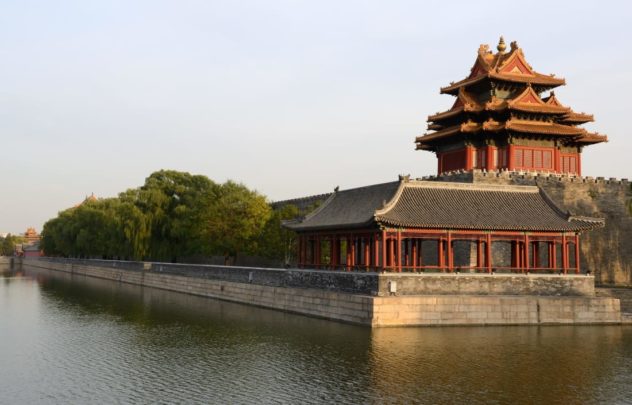© Frédéric Soltan/Corbis/Getty Images via CNN
Pre-reading questions:
I will read each question. Then, please answer them.
- What temples have you visited?
- Do you like visiting historical sites? Why or why not?
Vocabulary:
I will read the words, meanings, and sample sentences. Then, repeat after me.
- decade /DEK-eyd/
- supernatural /soo-per-NACH-er-uhl/
- ambience /AM-bee-uhns/
- interior /in-TEER-ee-er/
- endure /en-DOOR/
[noun] – a period of ten years
A lot of changes happened over the past 2 decades.
[adjective] – things that cannot be explained by science
Marina has a lot of books about supernatural phenomena.
[noun] – the character of a place or the quality it seems to have
The resort is expensive but the ambience is wonderful, so it’s worth it.
[noun] – the inside part of something
The ship’s interior needs immediate and extensive restoration.
[verb] – to experience and bear something difficult, painful, or unpleasant
As much as I want to, I just can’t endure loud music.
Article reading:
Please read the whole article. Then, I will check your pronunciation and intonation.
After six centuries, the Forbidden City in the heart of China’s capital still stands proud and strong, but what does it stand for? Back in 1981, American writer David Kidd visited Beijing after three decades but was instead welcomed by an unfamiliar scenery. Temples and city walls were replaced with factories and schools, respectively, yet amidst the changes, the imperial palace complex remains.
From the outside, the surroundings’ changes are visible but once you’re inside the palace complex, they remain the same as they were years ago. This is what the Forbidden City is capable of: fooling the eyes of visitors to think that nothing changed from within the palace walls. Kidd described this as an illusion “of supernatural space and time” in his book “Peking Story”.
The palace complex is immense and is the largest in the world, covering 720,000 square meters of land. It’s separated from the capital city with a 52-meter wide moat and a 10-meter high wall, giving off an intimidating ambience. The manor itself was structured to be this way to protect the emperor and impose his power over his people.
The intricate and symbolic designs of the palace complex’s interior don’t disappoint, either. The golden yellow tiles signify the emperor’s link to the sun, and the dragon symbolizes the power entrusted to him. The palace buildings made of wood were installed with lightning conductors to protect them from strikes; however, regular fires and natural disasters still affected the structure for six centuries.
Having endured 600 whole years of natural disasters and political conflict, the Forbidden City is appointed as China’s symbol of its rich history and culture. The government has heavily invested in both its restoration and preservation for the years to come. Will you list the Forbidden City of illusions as one of your tourist destinations in the future?
From the outside, the surroundings’ changes are visible but once you’re inside the palace complex, they remain the same as they were years ago. This is what the Forbidden City is capable of: fooling the eyes of visitors to think that nothing changed from within the palace walls. Kidd described this as an illusion “of supernatural space and time” in his book “Peking Story”.
The palace complex is immense and is the largest in the world, covering 720,000 square meters of land. It’s separated from the capital city with a 52-meter wide moat and a 10-meter high wall, giving off an intimidating ambience. The manor itself was structured to be this way to protect the emperor and impose his power over his people.
The intricate and symbolic designs of the palace complex’s interior don’t disappoint, either. The golden yellow tiles signify the emperor’s link to the sun, and the dragon symbolizes the power entrusted to him. The palace buildings made of wood were installed with lightning conductors to protect them from strikes; however, regular fires and natural disasters still affected the structure for six centuries.
Having endured 600 whole years of natural disasters and political conflict, the Forbidden City is appointed as China’s symbol of its rich history and culture. The government has heavily invested in both its restoration and preservation for the years to come. Will you list the Forbidden City of illusions as one of your tourist destinations in the future?
Comprehension Questions:
I will read each question. Then, please answer them based on the article.
- In the article, what did China appoint the Forbidden City as?
- What is the Forbidden City capable of according to the article?
- What were installed in the palace buildings to protect them from lightning strikes?
- In what year did David Kidd visit Beijing?
- How many square meters of land does the Forbidden City cover?
Discussion Questions:
I will read each question. Then, please answer them.
- Why do you think the imperial palace complex is called the Forbidden City?
- What is your opinion or thoughts about the designs inside the palace as described in the article?
- Do you think it is wise for the government to invest in the Forbidden City’s preservation? Please share your thoughts.
- What do you think is interesting about your country’s culture?
- For you, what is important when visiting a country’s historical place?
